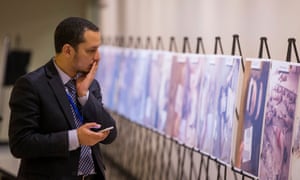
'Imagine your son or daughter was arrested. And you heard nothing about them for years. Until one day, thousands of photographs of dead bodies were published – corpses of people who had died in custody. You start looking through them one by one, sick to your stomach wondering if the next photograph you click on is of your loved one. But as you go through them, you realise many of the corpses are so severely emaciated, mutilated, some with their eyes missing, that you’d find it hard to recognise even yourself in that state.
Hundreds, if not thousands, of Syrian families have done just that – looked through the so-called Caesar photographs – images of over 11,000 people who apparently died in Syrian regime custody. A defector, codenamed Caesar, claimed he smuggled the photographs out of Syria and, astonishingly, that they had been taken by the regime itself as part of its record-keeping. Chillingly, each corpse has a number, alongside the number of a regime detention facility. No names, just numbers.
In May 2014, in part motivated by these images, the UN security council debated a draft resolution to refer Syria to the international criminal court. Thirteen of its 15 members voted for the resolution, but it was vetoed by Russia and China. The Syrian president, Bashar al-Assad, has consistently questioned the authenticity of the photographs, and when confronted with one of the horrific images by reporter Michael Isikoff in a Yahoo News interview last year, the president referred to them as “fake news”, and asked: “Who verified the pictures?”
New evidence suggests his own regime verified the pictures. War crimes investigators have recently uncovered documents they say provide corroboration of the Caesar photographs by the regime itself. Investigators at the Commission for International Justice and Accountability (many of them veterans of the international criminal court and the tribunal for the former Yugoslavia) discovered the evidence among hundreds of thousands of records abandoned by the Syrian regime when it lost control of areas to opposition forces.
The key documents are from the head of detention facility 227 to one of the regime’s senior intelligence chiefs, the head of military intelligence, informing him of the arrest, interrogation and deaths of detainees, and crucially, referring to their dead bodies with a number. When the investigators cross-checked these body numbers in the regime documents, with the corpse numbers and detention facility numbers displayed on bodies in the Caesar photographs, they matched. So not only do we have the Caesar photographs of thousands of corpses bearing marks of torture and starvation, we now have documents which appear to link the Syrian regime to some of the people in the photographs, and to their deaths. The photographs captured one moment in time, depicting the state of the detainees’ bodies. But the documents name the detainees, and talk about them from the time they were arrested, to the details gleaned from their interrogation, to the day they died, and finally, to what should be done with their bodies – confirming all of it happened in regime custody.
For example, among the Caesar photographs, corpse 2668, detention facility 227, is an emaciated man who appears to have had one eye gouged out. In the documents, he has a name, a village where he came from, the date he was arrested, what he confessed to during his interrogation, his death, and the cause given: “his heart and breathing stopping”. Somewhere he has a family, but the head of detention facility 227 didn’t recommend returning his body to them.
There are likely to be more of these documents because the records show the head of military intelligence asked to be informed of every single detainee death, and be consulted on what to do with the corpses. This is a man who, at the time the Caesar photographs were taken, held one of the most senior intelligence roles within Syria’s security structures, which report to President Assad.
Records reveal the regime knew detainees were being tortured and that deaths had risen considerably. A haunting new detail in the documents is the reference to detainees’ bodies being buried in a “known place”. Known to the regime, but as yet unknown to detainees’ families who are denied that information – an ongoing source of pain and anguish for them.
Why does all this evidence matter now? Because you only have to look at the calls from some quarters to lift sanctions on the Syrian regime, and at reports the Greek government, for instance, has already started importing phosphates from them, to know that steps are afoot to normalise this regime.
If that’s what people want, then they should own it. And they should understand exactly what they’re owning. Look at the Caesar photographs – just as families trying to identify their loved ones do – and ask whether it’s acceptable to normalise this.'
No comments:
Post a Comment